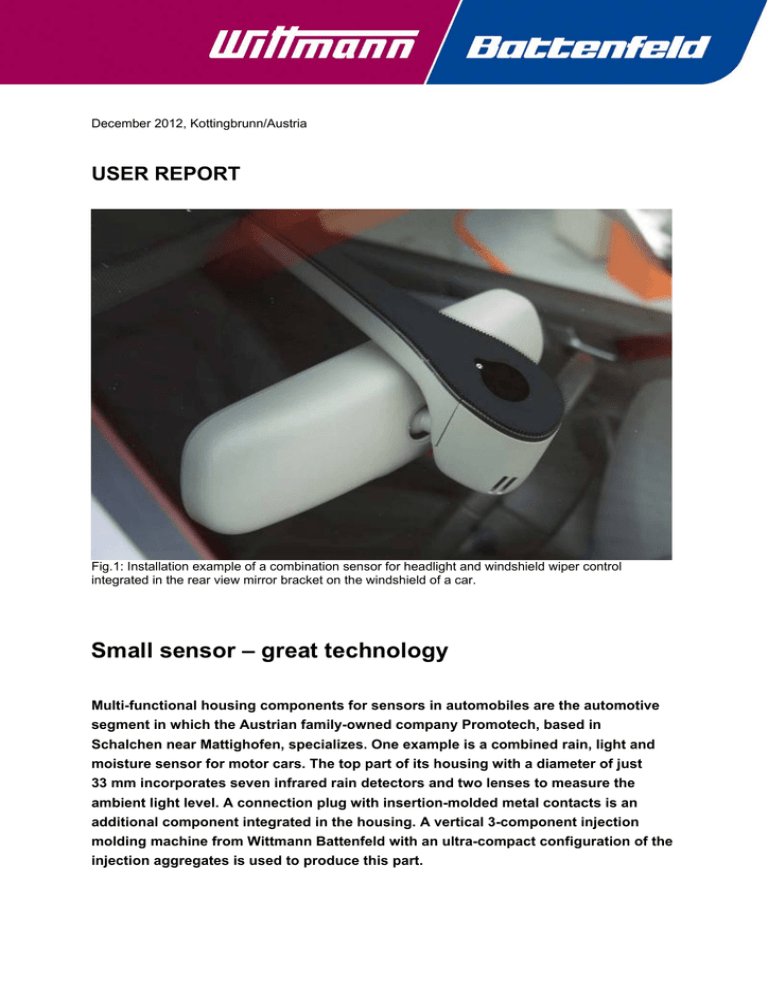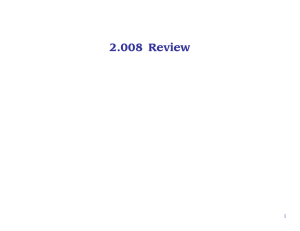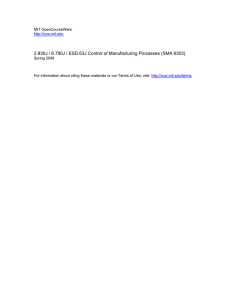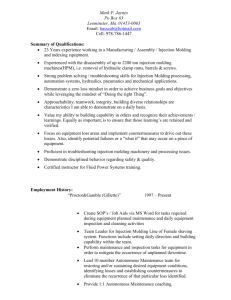Small sensor – great technology
advertisement

December 2012, Kottingbrunn/Austria USER REPORT Fig.1: Installation example of a combination sensor for headlight and windshield wiper control integrated in the rear view mirror bracket on the windshield of a car. Small sensor – great technology Multi-functional housing components for sensors in automobiles are the automotive segment in which the Austrian family-owned company Promotech, based in Schalchen near Mattighofen, specializes. One example is a combined rain, light and moisture sensor for motor cars. The top part of its housing with a diameter of just 33 mm incorporates seven infrared rain detectors and two lenses to measure the ambient light level. A connection plug with insertion-molded metal contacts is an additional component integrated in the housing. A vertical 3-component injection molding machine from Wittmann Battenfeld with an ultra-compact configuration of the injection aggregates is used to produce this part. Every modern car is equipped with an abundance of electronic systems to enhance both safety and comfort. Sensors are vital components of such systems. One such sensor is the rain/light/moisture sensor. Its housing consists of three different types of polycarbonate (Fig.2). Material number one is crystal-clear PC for the two lenses which measure the ambient light (to activate vehicle lighting) and the headlamp light of oncoming traffic (to control automatic dimming). Material number two is purple PC used to form six lenses positioned on the corners of a hexagon, as well as an additional central lens. These lenses support the emission and reception of infrared light rays. The rays are emitted by an LED lamp on one side and reflected by the boundary surface of the windshield to the receiver photodiode positioned on the other side. The infrared light ray, however, is only completely reflected as long as the windshield is dry. As soon as there are rain drops on the windshield, the reflection is disrupted, and only part of the light reaches the receiver diode. The difference in intensity compared to the degree of light reflection when the windshield is dry controls the function of the windshield wiper. The lenses are embedded in a housing made of black polycarbonate. Another integral part of the housing (with a total weight of less than five grammes) is a connector with three insert-molded male contacts (Fig.2c). The housings are also connected by means of a “flexband” to a moisture sensor, which detects moisture on the inside of the windshield and activates the blowers accordingly. Combination of micro and standard shot weights A comparison of the weights of the three polycarbonate components clearly shows that the production of this 3-component part requires a combination of micro with standard injection molding. Every molded part contains 0.1 g of crystal-clear PC, 0.2 g of purple PC and 4.2 g of black PC for the housing. With the required 4-cavity production, the total shot weights of 0.4, 0.8 and 16.8 grams still remain at the lower limit of standard injection molding technology, especially at the first two injection stations. Production without sprue where possible and consequently without the necessity for recycling was also aimed at. Accordingly, the choice of the ideal injection molding technology was a real challenge for the Promotech project team, especially since insertion and insert-molding of 3 contact pins for every part had to be integrated into the injection molding process as well. Christoph Feichtenschlager, project leader at Promotech, comments: “Our many years of experience in the production of metal/plastic hybrid parts prompted us to choose a vertical machine concept. We also wanted to inject all 3 material components directly, that is, via a hot runner system in each case. In spite of the shot volumes, some of which were extremely small, we wanted to minimize as much as possible the dwell times in the hot-runner distributors. So only the most compact injection molding system with the shortest possible melt paths and minimal melt volumes could suit our purpose. This concept provided the basis for our bidding procedure. Following comparison of several systems, we finally found that the concept proposed by the injection molding manufacturer Wittmann Battenfeld suited us best.” Ultra-compact vertical injection molding machine The Battenfeld solution is a machine model with the complex designation VM 100 / 210 / 60 / 60 R 752 (Fig. 3). This name stands for a machine with a vertical, fully hydraulic, 4-tie-bar, 100-ton clamping unit and a 3-station rotary table with a diameter of 752 mm and three injection units, which are also vertical, in sizes 60 (twice) and 210. The first two injection units with 14 mm screws are the smallest injection-molding aggregates with standard screws. The third aggregate is equipped with a 30 mm screw. Wolfgang Glawatsch, project coordinator at Battenfeld, comments: “Although we have used modules from our standard range as far as possible, the design of this system was anything but a standard task. As already mentioned above, minimization of the material paths and material quantities in the hot runner system was the top priority in the configuration, in order to keep the dwell time of the polycarbonate and consequently potential damage to the material below the critical level.” So all project partners had to target maximum compactness from the very beginning. Partners besides Wittmann Battenfeld were Mold Masters, as manufacturers of the hot runner systems, the mold-maker KTW and the automation equipment manufacturer MKE. Implementing this project required thinking out of the box at several points, for example, by concentrating the five original production steps required to make this multi-component injection-molded part (insertion of the metal pins, injection of 3 different materials, removal of finished parts) on only 3 stations. This concentration was the only way to accommodate the 3 x 4-cavity mold system on the 752 mm rotary table. Small-quantity injection molding packed extremely tight Integration of the two micro injections in one of the three rotary table stations makes it possible to use just one hot runner system for guiding both materials simultaneously on two levels via needle shut-off nozzles, each to the five injection points per cavity. Accordingly, the designers of the machine have placed the two smallest aggregates (designated as B and C in Fig.4) as close as possible to each other on the fixed platen of the machine. But in spite of all these machine and mold technology features, an additional process technology trick had to be used to ensure a safe material dwell time in the hot runners, i.e. by producing a smallvolume material disk together with each part, and then transferring it to the reclaim process by the parts removal handling system at the end of each cycle. During the next production step, the standard aggregate (A) insertion-molds the housing around the individual optical parts. At the third rotary table station, a handling device simultaneously removes the finished parts. This is immediately followed by placing the metal contact pins into the cavities, which is accomplished by a high-precision robot arm during the cooling period, all within the 21-second production cycle. Vertical injection molding system as part of a production cell The Wittmann Battenfeld injection molding system is only part of a complex production cell. In addition to the injection molding machine, this production cell incorporates two more rotary cycle systems, in which the finished injection-molded parts are inspected (plug function, completeness and dimensions of the finished part). Next, the parts are deposited on transport trays. The connection between the injection molding machine and the peripheral equipment for quality inspection and packaging is handled by several Scara robots. Simultaneously, the metal contact pins for the connection plug are punched, bent precisely and prepared for transfer by the handling system, all done by equipment contained in the same production cell. All in all, a lot of technology to produce a high-precision sensor component. “But in spite of all this complexity, our daily production practice furnishes the proof that we were on the right track with our concept, which is largely based on Wittmann Battenfeld’s experience in nano and micro injection molding”, says Günter Benninger, Managing Director at Promotech, in his status report, to which he adds an explicit commendation of the fast, competent after-sales support provided by the Battenfeld service team for this equipment. ■■■ about WITTMANN BATTENFELD WITTMANN BATTENFELD is a member company of the WITTMANN group and a leading manufacturer of injection molding machines for the plastics industry with its headquarters and production plant in Kottingbrunn / Lower Austria and sales and service companies as well as sales agencies in 60 countries worldwide. Its production program includes the complete range of injection molding machinery from micro injection molding machines up to large machines with 1,100 tons clamping force, as well as vertical machines and machines for multi-component injection molding. The range is rounded off by comprehensive application technology packages, which are complemented by the robotics and peripheral equipment range from Wittmann. More information from www.wittmann-group.com About PROMOTECH Promotech was established in 1995 and is a middle-sized, family-owned company with 180 associates. Its range of products and services includes punching technology, tooling and moldmaking, injection molding technology (specialty: insert molding) and automatic assembly technology. Its core competence lies in the field of mechatronical hybrid parts made of metal and plastics. The main product lines are parts for the automotive industry, primarily sensor and plug-and-socket connection assemblies in all conceivable sizes and variants. In parking sensors, Promotech covers about 60 per cent of the total global production with appox. 30 million units per annum. In addition to automotive components, the company also produces medical technology parts. Address: Unterlochen 44 A-5231 Schalchen Tel.: +43 (0)7742 4490-0 E-Mail: office@promotech.at Illustrations: , Fig.2a+b: The rain/light/moisture sensor is a 4-component part: two lenses made of crystal-clear PC, plus seven lenses made of purple PC, and the housing consisting of black PC. Three metal contact pins, which are placed into the mold and then insertion-molded, are the fourth component. Photo: courtesy of MKE Fig.3: The rain/light sensor housing consisting of 3 different types of PC and metal inserts is manufactured on a VM 100/210/60/60 R 752 vertical machine from Wittmann Battenfeld. It consists of a 100-ton, 4-tie-bar vertical clamping unit with a 752 mm rotary table and three vertical injection units for small shot weights. Fig.4: The three injection aggregates (A = size 210 with a 30 mm screw, B and C = size 60 with 14 mm screws) were positioned as close to each other as possible to be accommodated on the 752mm, 3-station rotary table, together with the hot runners laid out for minimal melt volumes. Fig.5a+b: A Scara robot connects the injection molding machine (Fig.5a) with the inspection station. Following inspection, the parts are deposited in transport trays by a transfer packaging station. Photo 6a: Courtesy of MKE Fig.6a+b: The Wittmann Battenfeld injection molding machine is part of a comprehensive production cell in which the punched parts for the contact plugs are produced and the finished injection-molded parts are inspected as well (plug function, completeness, dimensions). The plugs are subsequently deposited in transport trays. Fig.7: Wittmann Battenfeld project coordinator Wolfgang Glawatsch (left) and the Managing Partner of Promotech GmbH, Ing. Günter Benninger (right) expressing their satisfaction with the result at the end of 2 years of intensive cooperation in this project. Contact: WITTMANN BATTENFELD GmbH Wiener Neustädter Strasse 81 A-2542 Kottingbrunn Tel.: +43 2252 404-1400 Fax: +43 2252 404-991400 gabriele.hopf@wittmann-group.com www.wittmann-group.com



